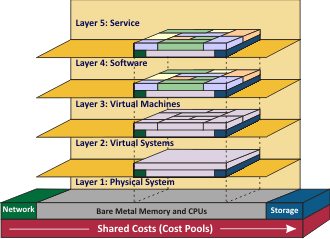Shared Resources
In order to achieve the
economies of scale within
IT operations, it is
necessary to share IT
resources. From outside of
IT, the cost of these
resources is easily
identified. The difficulty
begins when these IT costs
are to be applied back to
the external business
processes.
Cost Allocations
Shared resource costs
must be applied in a fair
and consistent manner so
that business process costs
are applicable and
measurable. When this
goal is achieved, there is
effective communications
between business users
and the IT group.
Controlled by IT
Better information about
business related IT cost
allows the IT group to
better control their costs.
They are able to forecast,
acquire, and provision
resources in a timelier
manner with optimum cost
consideration.
IT Cost Transparency:
Horizontal Cost
"If you don't measure it, you're just practicing" -- Robert Galvin
Shared Costs
To put it simply, shared IT resources
dictates that IT costs also be shared. This
situation is further complicated in that
most IT operations today are either
emulating a managed hosting service, or
are moving to one. This means that each
business consumer or service product has
a unique set of requirements that must be
provisioned using IT shared resources.
While it is possible to identify
dedicated resources used by a single
business consumer or service product,
the vast majorities of resources are
shared and must be apportioned
accordingly. The apportioning process
must also consider that each business
process will require that internal IT
resources be further apportioned (sub
divided) in order to achieve a fair and
consistent allocation of costs to the
business processes.
Horizontal Cost Allocation
Horizontal cost allocation can be thought of as the allocation of costs for a common set of IT
resources. In a Software Defined Datacenter, the horizontal costs are the costs associated with each
level of the cost model. The cost allocation process is further complicated in that some IT resources
may be applied to multiple levels of the model. For example, a support technician may support
hardware (Levels 1 and 3), and also support operating software (level 4).
RG Solutions® was designed with shared IT resources in mind. It uses a Resource Catalog that
supports Cost Pools, and these Cost Pools can be associated with one or more systems and/or one or
more workload groups. Whether using the inbuilt usage based allocation method or user defined
values, RG Solutions® fairly and consistently allocates the shared IT costs to the appropriate
business process.
Business Deliverables
The most valuable result of an IT Cost Transparency program is the information that is delivered to
the business. The business user will be able to understand the implications and cost associated with
their actions regarding IT resources. This information must include not only unit cost data, but also
the business usage patterns associated with the processing.
The best manner to deliver and use cost metrics is by utilizing the standard means that are
available to any business. RG Solutions® provides information that can be used for the consumer
budgeting, product cost analysis, product pricing decisions, competitive benchmarking, and other
business metrics. Its single biggest strength is the ability to integrate business information with cost
and technical data to get the cost information that the business needs, when it needs it.


